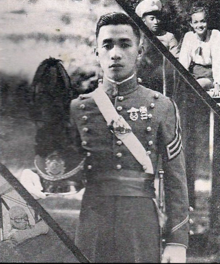Ramon A. Alcaraz
| Ramon A. Alcaraz | |
|---|---|

Philippine Military Academy photo - Class of 1940
|
|
| Birth name | Ramon Abacan Alcaraz |
| Nickname(s) | Monching, Parron |
| Born | August 15, 1915 Quingua, Bulacan, Philippine Islands |
| Died | June 25, 2009 (aged 93) Santa Ana, California, U.S. |
| Buried at | Fairhaven Memorial Park, Santa Ana, California, U.S. |
| Allegiance |
|
| Service/branch |
|
| Years of service | 1940-1941 (Army) 1941-1946 (USAFFE) 1946-1966 (Navy) |
| Rank |
|
| Unit |
Offshore Patrol - (USAFFE) Philippine Naval Patrol (Navy) |
| Commands held | Philippine Naval Operating Force Philippine Naval Fleet |
| Battles/wars |
World War II * Battle of Bataan |
| Awards | Silver Star (USA) |
Commodore Ramon Abacan Alcaraz (August 15, 1915 - June 25, 2009) was an officer in the Philippine Navy during the Second World War. A member of the 1st graduating class (4-year curriculum) of the Philippine Military Academy in 1940. He served with Philippine Army after graduation then joined the Offshore Patrol unit of the U.S. Army Forces in the Far East (USAFFE), predecessor of the Philippine Navy. Imprisoned by the Japanese after the Fall of Bataan in Malolos POW Camp.
Alcaraz was born on August 15, 1915 in Quingua, Bulacan, Central Luzon, Philippines. Son of Domingo Lipana Alcaraz and Maxima Cruz Abacan. He is the oldest of two brothers, Mariano 'Rocky' (Capt., Philippine Navy, Ret.).
He entered the Philippine Military Academy at Teachers Camp, Baguio City, Mountain Province, Philippines from June 15, 1936 to March 15, 1940 where he graduated with a Bachelor of Science degree. Alcaraz graduating among the 79 members (originally 120 cadets) from the Class of 1940 "The Pioneer Class". His class was the first group of graduates to finish the four year curriculum, as the previous curriculum was only three years. Alcaraz was a writer for the PMA publication "Corps" and the bantam weight boxing champion in 1937 and 1938.
In 1941, he voluntarily joined and graduated from the Army's newly formed Offshore Patrol (OSP) Training School in Manila as part of the USAFFE forces. In 1959, he went to United States to study at the Naval War College - Command Course at Newport, Rhode Island.
After graduation, he assigned as a 3rd Lieutenant to the Philippine Commonwealth Army. Nineteen months later, he volunteered to the newly formed Offshore Patrol unit of the Army and promoted as a 2nd Lieutenant with the OSP - Sea duty forces. A few weeks after the Japanese attack on Pearl Harbor, he was promoted as a 1st Lieutenant after he was inducted into the U.S. Army Forces in the Far East (USAFFE). He was the Commanding Officer of the Q-112 Abra, a 55 ft stepped-hull torpedo boat with aftward launch torpedo chutes built for the Philippine Commonwealth Government by the British shipbuilding firm John I. Thornycroft & Company - one of three "Q-boat" torpedo boats used by the Offshore Patrol (OSP) during the war.
...
Wikipedia
